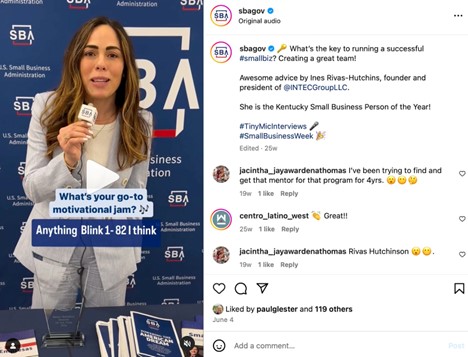This column was originally published on Catie Miller’s blog at Public Social, I Love You and was republished here with permission from the author.
It turns out small businesses are big business. They account for over 40% of our nation’s economic output and create two-thirds of net new jobs.
The U.S. Small Business Administration is the only agency in the federal government that’s fully dedicated to small businesses. With many entrepreneurs and makers extremely active on social media, it’s important for SBA to meet them where they are. This week I spoke to Paul Lester, the man behind SBA’s social media.
If you have ever wondered if your public social makes an impact…

Then take a look at #ShopSmall as a prime example. Paul and his strategy of motivation, showcasing real people, and sharing helpful facts A) helps people access the SBA’s resources, and B) gets eyes on real Americans and their companies.
And this year, 15 years after it began, Small Business Saturday (on Thanksgiving weekend) is more important than ever. According to a recent poll released by American Express, over 80% of small businesses surveyed said that this year’s Small Business Saturday would be critical to their ability to stay afloat. This checks out with my own feeds, where I’ve seen an uptick in posts from makers and small businesses, such as this one from Reclaim Creative.
The good news is that Small Business Saturday has generated over $201 billion dollars over the past 15 years. So there is a good chance that if we #ShopSmall this holiday season, many makers will flourish in the new year.
Catie Miller: First, can you tell me about your role?
Paul Lester: I’m a Public Affairs Specialist with the SBA and I manage the agency’s flagship social media accounts. I also coordinate with other communication professionals at the agency’s 68 district offices across the country. I previously served in a similar role at the U.S. Department of Energy. I’ve been in public service for nearly 10 years and love it.
CM: How would you describe the SBA’s social strategy?
PL: We try to uplift small business owners who have received SBA support by featuring them on Instagram and our other social media accounts. This helps the owner get national exposure and hopefully a few more followers.
We also seek to highlight resources to help entrepreneurs start and grow businesses. This can include posting “tips” and resources, creating short-form animations, promoting resource partner webinars, and more.
CM: Tell me about #ShopSmall.
Every year, Small Business Saturday kicks off the holiday shopping season during Thanksgiving weekend. This year it falls on Saturday, November 30. Many independent retailers, restaurants, and venues rely on brisk sales during the holidays, which can help them grow or expand their businesses in the new year.
Over the last few years, consumers have spent billions of dollars at small businesses on Small Business Saturday. Leading up to Small Business Saturday this year, SBA will encourage Americans to #ShopSmall and support the job creators in their community. This includes free toolkits on our site for business owners and graphics for other social media professionals.
Following Small Business Saturday, our Season of Small Business campaign will continue to highlight the importance of shopping at locally owned stores throughout the holidays and beyond.
View on Threads
CM: About your content calendar. Are you able to be reactive or do you have to plan your content out weeks in advance?
PL: I typically try to plan at least a week out in advance but sometimes further. Every month, we create a social media guide that includes graphics and sample posts for the district office communication teams so that they can re-purpose the content for their social media accounts. District offices are very small and public affairs specialists typically have multiple roles and can’t devote a lot of time to social media so the monthly guides can help them quickly fill any content gaps.
For big events like National Small Business Week or Small Business Saturday (#ShopSmall), we plan content weeks in advance since it’s such a major priority for the agency.
CM: Can you share a recent trend you are seeing? Do you have a favorite?

PL: We are finding there is a desire for more in person (IRL!) events and we have leaned into that.
By hosting events for National Small Business Week, we were able to directly interact with small business owners and create content for Instagram Reels.
We also try to track what type of content and trends are popular on social media. One of my favorite examples is the “of course” Instagram Reels, which trended this past spring. I was able to reach out to a few small business owners who graciously provided short video clips, which I used to create a Reel.
CM: Earlier this year, SBA joined Threads, and your strategy has been a little different there. Share more about this decision.
PL: Yes! We already knew that small businesses are very active on Instagram since the platform is focused on visuals and selling products but shortly after launching our Threads account we noticed a lot more microentrepreneurs and solo entrepreneurs on the platform who were posting about how much they need to hustle and grind every day for their business to succeed.
We leaned into that a little and started posting inspirational quotes — either famous ones or ones we wrote ourselves. Those types of posts are resonating with small business owners, which is who we are trying to connect with.
View on Threads
CM: I loved how you have leaned into “hustle culture” with these posts. They don’t have links, which helps with the algorithm and seem to be pretty popular.
PL: By far, they are the most successful content on our Threads account! Posts like “Reminder: Growth isn’t a straight path” are a way of celebrating business owners who may need that extra little boost of motivation to power through the day. Even though we aren’t directly promoting SBA services, we’re still engaging and connecting with those who will use them.
Copyright
© 2024 Federal News Network. All rights reserved. This website is not intended for users located within the European Economic Area.





